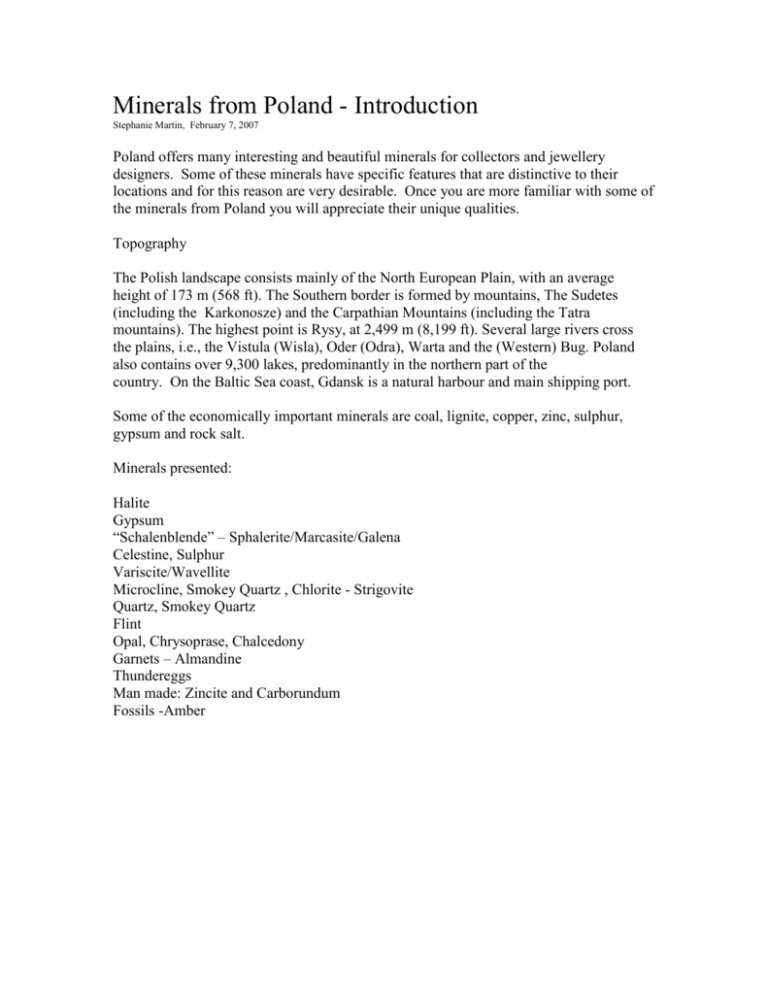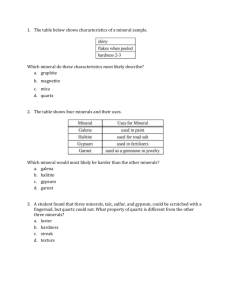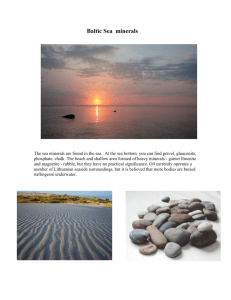Minerals from Poland - Calaverite Fine Minerals
advertisement

Minerals from Poland - Introduction Stephanie Martin, February 7, 2007 Poland offers many interesting and beautiful minerals for collectors and jewellery designers. Some of these minerals have specific features that are distinctive to their locations and for this reason are very desirable. Once you are more familiar with some of the minerals from Poland you will appreciate their unique qualities. Topography The Polish landscape consists mainly of the North European Plain, with an average height of 173 m (568 ft). The Southern border is formed by mountains, The Sudetes (including the Karkonosze) and the Carpathian Mountains (including the Tatra mountains). The highest point is Rysy, at 2,499 m (8,199 ft). Several large rivers cross the plains, i.e., the Vistula (Wisla), Oder (Odra), Warta and the (Western) Bug. Poland also contains over 9,300 lakes, predominantly in the northern part of the country. On the Baltic Sea coast, Gdansk is a natural harbour and main shipping port. Some of the economically important minerals are coal, lignite, copper, zinc, sulphur, gypsum and rock salt. Minerals presented: Halite Gypsum “Schalenblende” – Sphalerite/Marcasite/Galena Celestine, Sulphur Variscite/Wavellite Microcline, Smokey Quartz , Chlorite - Strigovite Quartz, Smokey Quartz Flint Opal, Chrysoprase, Chalcedony Garnets – Almandine Thundereggs Man made: Zincite and Carborundum Fossils -Amber Minerals from Poland Stephanie Martin February 7, 2007 Halite - Otherwise known as rock salt. Halite was mined since the middle ages at Wieliczka. The mine is now closed but the site is listed as a Unesco World Heritage site and is an interesting tourist attraction. The Wieliczka salt mine contains a museum below ground with sanatorium, theatre, church and café. Many old sculptures are displayed and everything from stairs to chandeliers are made from salt. Salt mining now continues in Klodawa and a few other other regions. Coloured halite is a novelty and is prized by collectors. Colouring can be caused by such reasons as mineral impurities, bacteria present at formation and irradiation. Typical examples are pink from bacteria, green from algae or copper, yellow/orange from iron, blue due to irradiation. Blue halite has been found in meteorites. Gypsum – Gypsum is an important economic mineral. It occurs in massive granular form as well as crystals (selenite). It has the ability to be ground into powder and then rehydrated to become an important building material for cement and wallboard. Aside from its economic importance the crystals when formed are aesthetically pleasing. Common twinning occurs and are known as “fishtails”. Gypsum can also be coloured by impurities. Green gypsum found at Lubin copper mine is due to copper content. “Schalenblende” - Lapidary artists love the beautiful patterns formed by this famous mix of minerals known as schalenblende. This is a particular combination of botryoidal sphalerite ( which is also fluorescent), layered with marcasite and galena and sometimes wurtzite. These minerals are stunning when polished. The location of Olkusz is famous for schalenblende. Celestine/Sulphur – Classic combo from large sulphur producing area at Tarnobrzeg. Beautiful champagne crystals of celestine on sulphur matrix. Long prismatic habit. Fluorescent and phosphorescent. Variscite/Wavellite - Poland is a little known location for these minerals, but once seen you will appreciate their appeal. Hard to distinguish between the two as both may be present in either botryoidal or radiating habit. Found in limestone deposits at Wisniowka. Fluorescent and phosphorescent. Microcline/Smoky Quartz, Chlorite - Strzegom is a famous pegmatite location. Over 70 minerals are known to be found in this area. Classic combinations of microcline and smoky quartz dusted with chlorites (Strigovite) are notable. Quartz - Nice rock crystal quartz is found at Jeglowa. Phantom quartz at Jaroszow. Amethyst with hematite inclusions from Karpacz. Flint – Flint is actually a variety of microcrystalline quartz. In Britain flint nodules were used in construction to make dwellings durable. Many of these flint nodules are still evident today after centuries of wear. Flint was of course used in Neolithic times as tools. The earliest evidence of mining in Poland dates back to 3500 BC when flint was mined by Neolithic tool makers. In Krzemionki Opatowskie, there is one of the world's best preserved flint workings (3500-1200 BC). This is also one of the most valuable archeological sites in Europe. In addition to its usefulness, flint can also be very beautiful. In certain areas of Poland such as Niwa and Ilza, spectacular banded nodules can be found. Banded flint is highly sought after for decorative purposes as well as for jewellery. Chalcedony/Opal/Chrysoprase – More microcrystalline quartz. These lapidary favourites were heavily mined at Szklary near Zabkowice. This location was formerly known as Frankenstein while under German ownership. Beautiful mint to apple green chrysoprase is known from there as well as milky and moss opal. Garnets - Almandine garnets are found in many locations. Karpacz, Krobica, and Gebczyce to name a few. Thundereggs - When you think of agates one would not suspect that Poland would have a lot to consider. There are in fact several agate rich areas that have provided wonderful examples. Many colourful agate nodules are found at Ploczki and Rozana. Intricately banded and decorative geodes known as Thundereggs are highly prized from Nowy Kosciol. Found in the southern mountain regions. Some fluoresce. Man made by-products Zincite and Carborundum – Both of these examples are byproducts of human manufacturing. Zincite is formed in smokestacks. Zincite was produced because of an engineering flaw in zinc smelters that allowed much of the zinc to escape up the stacks. These have now been corrected and no more new zincite is being produced. Carborundum is manufactured through coal processing. Poland is lessening its dependence on coal. Fossils – Poland has a broad range of fossil periods which to study. Notable are the devonian, carboniferous and miocene. Of course the most famous of all is Baltic Amber. Baltic Amber - Eocene - Known as the “Gold of the North”, amber has a long history in Europe. Amber is the fossilized resin (not sap) of Tertiary conifers, sometimes with insects or plant fragments inside. Since prehistoric times it has been used for producing jewellery and decorative elements. Trade routes were established in Europe as a result of the amber trade. Gdansk (formerly Danzig) was the amber producing centre. The first amber guild was formed in 1480. Amber trade was once strictly controlled by ruling political interests. Today there is a street in Gdansk known as the “Amber Road” due to the large amount of amber still sold there. Kaliningrad in the Russian enclave just north of Poland is now the largest commercial operation to recover amber from the Baltic Sea. The original famous Russian “Amber Room” was made with Baltic amber. A replica was reconstructed and completed in 2003.







